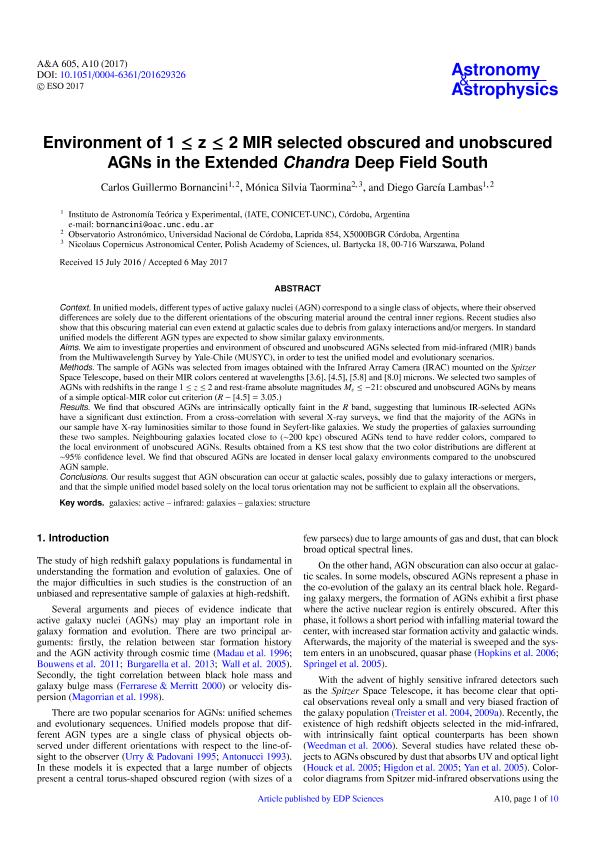Artículo
Environment of 1 ≤ z ≤ 2 MIR selected obscured and unobscured AGNs in the Extended Chandra Deep Field South
Fecha de publicación:
09/2017
Editorial:
EDP Sciences
Revista:
Astronomy and Astrophysics
ISSN:
0004-6361
Idioma:
Inglés
Tipo de recurso:
Artículo publicado
Clasificación temática:
Resumen
Context. In unified models, different types of active galaxy nuclei (AGN) correspond to a single class of objects, where their observed differences are solely due to the different orientations of the obscuring material around the central inner regions. Recent studies also show that this obscuring material can even extend at galactic scales due to debris from galaxy interactions and/or mergers. In standard unified models the different AGN types are expected to show similar galaxy environments. Aims. We aim to investigate properties and environment of obscured and unobscured AGNs selected from mid-infrared (MIR) bands from the Multiwavelength Survey by Yale-Chile (MUSYC), in order to test the unified model and evolutionary scenarios. Methods. The sample of AGNs was selected from images obtained with the Infrared Array Camera (IRAC) mounted on the Spitzer Space Telescope, based on their MIR colors centered at wavelengths [3.6], [4.5], [5.8] and [8.0] microns. We selected two samples of AGNs with redshifts in the range 1 ≤ z ≤ 2 and rest-frame absolute magnitudes Mv ≤ -21: obscured and unobscured AGNs by means of a simple optical-MIR color cut criterion (R - [4:5] = 3:05.) Results. We find that obscured AGNs are intrinsically optically faint in the R band, suggesting that luminous IR-selected AGNs have a significant dust extinction. From a cross-correlation with several X-ray surveys, we find that the majority of the AGNs in our sample have X-ray luminosities similar to those found in Seyfert-like galaxies. We study the properties of galaxies surrounding these two samples. Neighbouring galaxies located close to (~200 kpc) obscured AGNs tend to have redder colors, compared to the local environment of unobscured AGNs. Results obtained from a KS test show that the two color distributions are different at ~95% confidence level. We find that obscured AGNs are located in denser local galaxy environments compared to the unobscured AGN sample. Conclusions. Our results suggest that AGN obscuration can occur at galactic scales, possibly due to galaxy interactions or mergers, and that the simple unified model based solely on the local torus orientation may not be sufficient to explain all the observations.
Palabras clave:
Galaxies: Active
,
Galaxies: Structure
,
Infrared: Galaxies
Archivos asociados
Licencia
Identificadores
Colecciones
Articulos(IATE)
Articulos de INST.DE ASTRONOMIA TEORICA Y EXPERIMENTAL
Articulos de INST.DE ASTRONOMIA TEORICA Y EXPERIMENTAL
Citación
Bornancini, Carlos Guillermo; Taormina, Mónica Silvia; Garcia Lambas, Diego Rodolfo; Environment of 1 ≤ z ≤ 2 MIR selected obscured and unobscured AGNs in the Extended Chandra Deep Field South; EDP Sciences; Astronomy and Astrophysics; 605; A10; 9-2017
Compartir
Altmétricas




